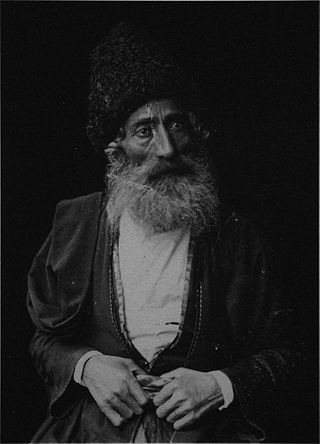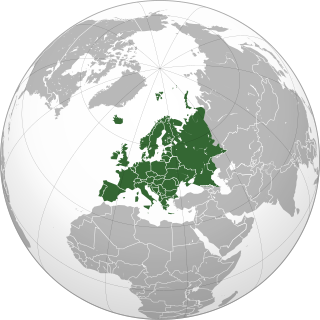Related Research Articles

Ashkenazi Jews, also known as Ashkenazic Jews or Ashkenazim, are a Jewish diaspora population who formed in the Holy Roman Empire around the end of the first millennium CE. Their traditional diaspora language is Yiddish, which developed during the Middle Ages after they had moved from Germany and France into Northern Europe and Eastern Europe. For centuries, Ashkenazim in Europe used Hebrew only as a literary and sacred language until the revival of Hebrew as a common language in 20th-century Israel. Throughout their numerous centuries living in Europe, Ashkenazim have made many important contributions to its philosophy, scholarship, literature, art, music, and science.

Georgian Jews are a community of Jews who migrated to Georgia during the Babylonian captivity in the 6th century BCE. It is one of the oldest communities in that land.

Jewish history is the history of the Jews, and their nation, religion, and culture, as it developed and interacted with other peoples, religions, and cultures.

Aliyah is the immigration of Jews from the diaspora to, historically, the geographical Land of Israel, which is in the modern era chiefly represented by the State of Israel. Traditionally described as "the act of going up", moving to the Land of Israel or "making aliyah" is one of the most basic tenets of Zionism. The opposite action—emigration by Jews from the Land of Israel—is referred to in the Hebrew language as yerida. The Law of Return that was passed by the Israeli parliament in 1950 gives all diaspora Jews, as well as their children and grandchildren, the right to relocate to Israel and acquire Israeli citizenship on the basis of connecting to their Jewish identity.

The Damascus affair of 1840 refers to the arrest of several notable members of the Jewish community in Damascus on the accusation of murdering Father Thomas, a Christian monk, and his Muslim servant for the purpose of using their blood to bake matzo, an antisemitic accusation also known as the blood libel.

The history of the Jews in England goes back to the reign of William the Conqueror. Although it is likely that there had been some Jewish presence in the Roman period, there is no definitive evidence, and no reason to suppose that there was any community during Anglo-Saxon times. The first written record of Jewish settlement in England dates from 1070. The Jewish settlement continued until King Edward I's Edict of Expulsion in 1290.

The history of the Jews in Germany goes back at least to the year 321, and continued through the Early Middle Ages and High Middle Ages when Jewish immigrants founded the Ashkenazi Jewish community. The community survived under Charlemagne, but suffered during the Crusades. Accusations of well poisoning during the Black Death (1346–53) led to mass slaughter of German Jews and they fled in large numbers to Poland. The Jewish communities of the cities of Mainz, Speyer and Worms became the center of Jewish life during medieval times. "This was a golden age as area bishops protected the Jews resulting in increased trade and prosperity."
As of 2023, the world's "core" Jewish population was estimated at 16 million, 0.2% of the 8 billion worldwide population. This number rises to 18 million with the addition of the "connected" Jewish population, including those who say they are partly Jewish or that have Jewish backgrounds from at least one Jewish parent, and rises again to 21 million with the addition of the "enlarged" Jewish population, including those who say they have Jewish backgrounds but no Jewish parents and all non-Jewish household members who live with Jews. Counting all those who are eligible for Israeli citizenship under Israel's Law of Return, in addition to Israeli Jews, raised the total to 23.8 million.

Leonid Borisovich Nevzlin is a Russian-born Israeli businessman, investor, and philanthropist.

The history of the Jews in Europe spans a period of over two thousand years. Some Jews, a Judaean tribe from the Levant, migrated to Europe just before the rise of the Roman Empire. Although Alexandrian Jews had already migrated to Rome, a notable early event in the history of the Jews in the Roman Empire was the 63 BCE siege of Jerusalem.

The Second Aliyah was an aliyah that took place between 1904 and 1914, during which approximately 35,000 Jews immigrated into Ottoman-ruled Palestine, mostly from the Russian Empire, some from Yemen.
As an organized nationalist movement, Zionism is generally considered to have been founded by Theodor Herzl in 1897. However, the history of Zionism began earlier and is intertwined with Jewish history and Judaism. The organizations of Hovevei Zion, held as the forerunners of modern Zionist ideals, were responsible for the creation of 20 Jewish towns in Palestine between 1870 and 1897.
Shaul Stampfer is a researcher of East European Jewry specializing in Lithuanian yeshivas, Jewish demography, migration and education.
Zionist-Socialist Workers Party, often referred to simply as Zionist-Socialists or S.S. by their Russian initials, was a Jewish territorialist and socialist political party in the Russian Empire and Poland, that emerged from the Vozrozhdenie (Renaissance) group in 1904. The party held its founding conference in Odessa in 1905.

Jews or Jewish people are an ethnoreligious group, nation or ethnos originating from the ancient Israelites and Hebrews of historical Israel and Judah. Jewish ethnicity, nationhood, and religion are strongly interrelated, as Judaism is the ethnic religion of the Jewish people, although its observance varies from strict to none.
Antisemitism in the Russian Empire included numerous pogroms and the designation of the Pale of Settlement from which Jews were forbidden to migrate into the interior of Russia, unless they converted to the Russian Orthodox state religion.

The expression 'Eastern European Jewry' has two meanings. Its first meaning refers to the current political spheres of the Eastern European countries and its second meaning refers to the Jewish communities in Russia and Poland. The phrase 'Eastern European Jews' or 'Jews of the East' was established during the 20th century in the German Empire and in the western provinces of the Austro-Hungarian Empire, aiming to distinguish the integrating Jews in Central Europe from those Jews who lived in the East. This feature deals with the second meaning of the concept of Eastern European Jewry- the Jewish groups that lived in Poland, Ukraine, Belarus, Latvia, Lithuania, Estonia, Russia, Romania, Hungary and modern-day Moldova in collective settlement. Many of whom spoke Yiddish.
Jonathan Frankel was a historian and writer. He was a lecturer at the Hebrew University of Jerusalem from 1964 to 1985, and a professor between 1985 and 2004.
The history of the Jews in Saint Petersburg dates back to the 18th century and there is still a Jewish community in the city today. In the late 18th century, the annexation of eastern Poland meant millions more Jews were now subjects of the Russian Empire, many of whom flocked to the city. When Catherine the Great created the Pale of Settlement to attempt to contain the new Jewish population, Jewish settlement was largely restricted. Under Tsar Alexander II upper class Jews fitting certain criteria were allowed to live in the city, and many other Jews who did not fit these categories settled illegally. By the end of his reign in 1881, the Jewish population of the city was 17,253. Unlike other cities in the Russian Empire, Saint Petersburg never had a pogrom, likely due to the amount of police and army presence it had as the capital. The community continued to grow, despite expulsions and persecution, and flourished creatively until the Bolshevik Revolution. Under the Soviet Union, Jewish life was stifled and repressed, and a number of Saint Petersburg Jews took part in the refusenik movement and underground revival of Jewish nationalism. Today, after the collapse of the Soviet Union, the city remains home to a sizable Jewish community and many Jewish institutions. The Grand Choral Synagogue of Saint Petersburg is the third-largest synagogue in Europe.
This article lists Jewish population estimates by scope, by year, by country and by geographical area.
References
- ↑ "Semion Goldin (1967–) | The National Library of Israel". www.nli.org.il.
- ↑ "Semion Goldin". The Hebrew University of Jerusalem.
- ↑ "Semion Goldin". nevzlincenter.huji.ac.il.
- ↑ Goldin, Semion (2022). ""The Jewish Question" and the Political Situation in Russia". The Russian Army and the Jewish Population, 1914–1917. pp. 215–250. doi:10.1007/978-3-030-99788-5_8. ISBN 978-3-030-99787-8.
- ↑ Goldin, Semion (2010). "Jews as cosmopolitans, foreigners, revolutionaries. Three images of the Jew in Polish and Russian nationalist ideology at the end of the nineteenth and early twentieth centuries". European Review of History: Revue Européenne d'Histoire. 17 (3): 431–444. doi:10.1080/13507486.2010.481941. S2CID 159880813.
- ↑ Goldin, Semion (2022). "The Russian Army and the Jews at the Start of the Twentieth Century". The Russian Army and the Jewish Population, 1914–1917. pp. 15–39. doi:10.1007/978-3-030-99788-5_2. ISBN 978-3-030-99787-8.
- ↑ Goldin, Semion (2022). "Army Authority and Activity in the Sphere of Civilian Administration". The Russian Army and the Jewish Population, 1914–1917. pp. 41–72. doi:10.1007/978-3-030-99788-5_3. ISBN 978-3-030-99787-8.
- ↑ Goldin, Semion (2022). "The Russian Army Command and the Negative Stereotype of the Jew". The Russian Army and the Jewish Population, 1914–1917. pp. 73–108. doi:10.1007/978-3-030-99788-5_4. ISBN 978-3-030-99787-8.
- ↑ Goldin, Semion (June 2022). The Russian Army and the Jewish Population, 1914–1917: Libel, Persecution, Reaction. ISBN 978-3-030-99788-5.
- ↑ Goldin, Semion (2022). "Soldiers, Officers, and the Jewish Population of the Frontal Zone". The Russian Army and the Jewish Population, 1914–1917. pp. 179–213. doi:10.1007/978-3-030-99788-5_7. ISBN 978-3-030-99787-8.
- ↑ Goldin, Semion (2022). "Deportations of the Jewish Population and Hostage Taking (1914–1915)". The Russian Army and the Jewish Population, 1914–1917. pp. 109–143. doi:10.1007/978-3-030-99788-5_5. ISBN 978-3-030-99787-8.
- ↑ https://encyclopedia.1914-1918-online.net/pdf/1914-1918-Online-antisemitism_and_pogromsin_the_military_russian_empire-2014-10-08.pdf
- ↑ Goldin, Semion (3 June 2022). The Russian Army and the Jewish Population, 1914–1917: Libel, Persecution, Reaction. ISBN 978-3-030-99787-8.
- ↑ Goldin, Semion (3 June 2022). The Russian Army and the Jewish Population, 1914–1917: Libel, Persecution, Reaction. ISBN 978-3-030-99787-8.
- ↑ Goldin, Semion; Spiro, Mia; Ury, Scott (9 June 2020). Jewish Migration in Modern Times: The Case of Eastern Europe. ISBN 978-0-429-59034-4.
- ↑ Goldin, Semion; Spiro, Mia; Ury, Scott (30 September 2020). Jewish Migration in Modern Times: The Case of Eastern Europe. ISBN 978-0-367-66093-2.